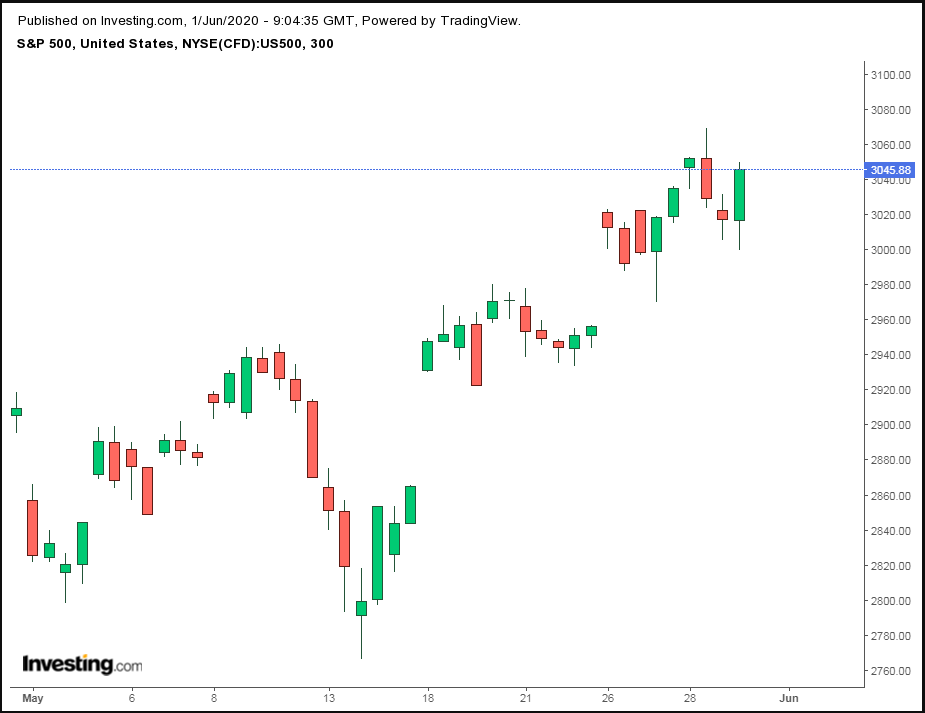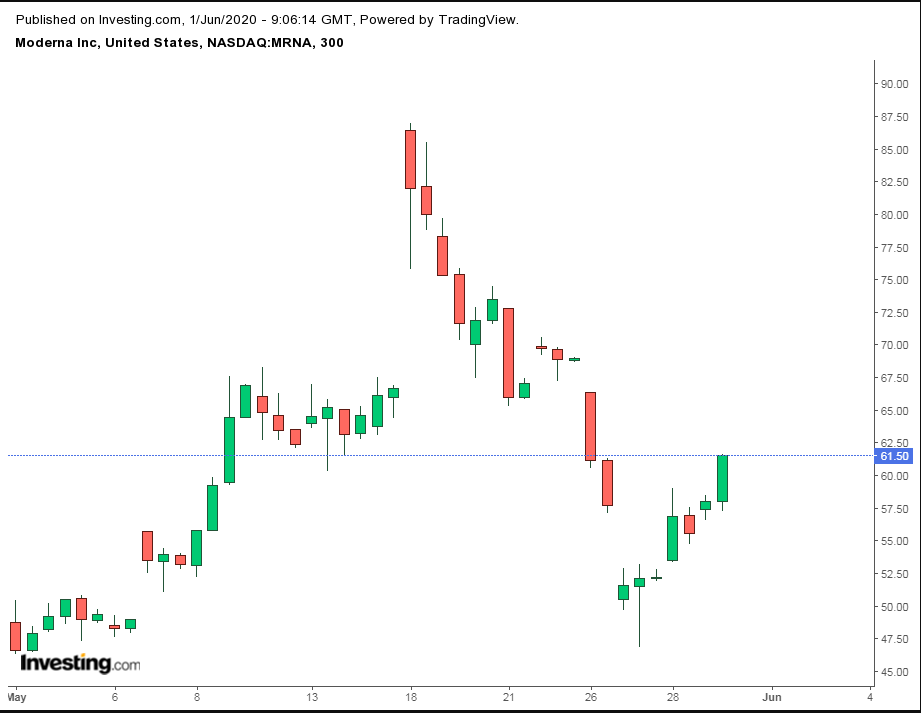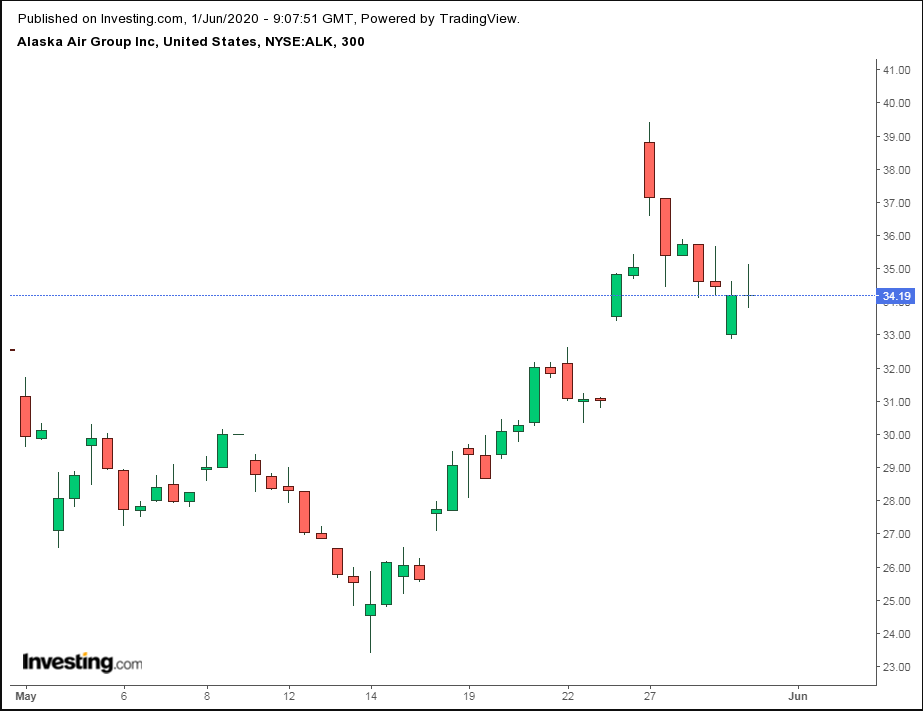The U.S. stock market finished May with a flourish and could have room to move even higher. Prices and trading volumes were strong, especially in the final week of the month as investors were cheered by Americans finding ways to enjoy the Memorial Day holiday and forget the coronavirus problems.
The S&P 500 rose 4.53% in May, a solid gain after the index jumped 12.7% in April.

The two-month acceleration represents +17.8%, a performance not seen since the 18.7% gain in March-April 2009 after the market bottom during the Great Recession. More important perhaps, the rally that started in March 2009 mostly held for the next five years.
A successful recovery now and long-lived rally like the one in 2009 will depend on a number of factors:
- The Federal Reserve continuing to add more money into the banking system and keeping interest rates low. (The 10-year Treasury yield closed Friday at 0.653%.) Central banks elsewhere are pledging the same thing.
- The federal government continuing to provide stimulus.
- In the United States, the reopening of businesses, schools and other activities at a reasonable speed.
- Gaining control of the coronavirus pandemic. So far there are more than 6-million cases reported globally with more than 372,000 deaths worldwide. U.S. cases are nearing 1.8 million with nearly over 104,000 deaths. There is a frantic race occurring to develop, test, mass-produce and mass-distribute a vaccine.
All of which looks complicated. And it is.
Plus, those prerequisites have to work through the continuing trade battles between the United States and China.
As well, the U.S. elections this fall are almost certain to be divisive, especially on the heels of the protests and riots that erupted across the United States this weekend after the killing of Floyd George in Minneapolis last week.
Plenty Of Fundamental Risk, New Market Stars
Any of these issues could derail the rally with dramatic selloffs like those that routinely occurred as the Trump administration attempted to negotiate the first phase of a trade deal with China.
But, on the upside for investors, market technicals suggest stocks are not overvalued as they were in January and February. The NASDAQ, NASDAQ 100 and NASDAQ Biotechnology Index (NBI) are ahead on the year and could reach new highs, perhaps this week.
The May market performance was different from the April rally that produced the best one-month gains for the S&P 500 and the Dow since 1987.
In addition to the S&P 500 gains, the Dow (INDU) added 4.26% for the month, compared with 11.1% in April. The NASDAQ Composite (NDX) was up 6.75%, down from 15.5% the month previous. The NASDAQ 100, which is dominated by big tech stocks, added 6.17%.
April's rally was heavily influenced by gains in big tech shares, including Apple (NASDAQ:AAPL), Microsoft (NASDAQ:MSFT), Amazon (NASDAQ:AMZN), Facebook (NASDAQ:FB) and Netflix (NASDAQ:NFLX).
May's move higher had more to do with star performances in other sectors of the market, especially biotechs.
Biotechnology stocks jumped more than 8% after investors wanted in on the hunt for a coronavirus vaccine as well as cures for other diseases, especially cancers.
Shares of Novavax (NASDAQ:NVAX), a small Maryland biotech, jumped 154% on the hopes that its coronavirus candidate could be a winner. The release by Moderna (NASDAQ:MRNA), a clinical stage biotech based in Cambridge, Massachusetts of some early but positive results pushed its stock up to as high as $87 and set off a 912-point Dow rally.

Though the shares fell back to $61.50, they're still up 33.7% for the month.
Also working on vaccines are big pharma stalwarts Merck (NYSE:MRK), Johnson & Johnson (NYSE:JNJ) and Pfizer (NYSE:PFE). Shares of Gilead Sciences (NASDAQ:GILD) have been volatile as studies continue using its drug remdesivir to treat the disease.
The S&P 400 Midcap Index (MID) and Russell 2000 also saw gains: 7.1% for the mid-cap benchmark and 6.36% for the Russell.
Homebuilding and real estate shares moved on data showing home prices are holding steady in many markets. KB Home (NYSE:KBH) jumped 26% during the month. PulteGroup (NYSE:PHM), Lennar (NYSE:LEN) and DR Horton (NYSE:DHI) had similar gains.
Airline shares plunged in April but showed signs of stabilization in May.

Alaska Airline Group (NYSE:ALK), down nearly 44% in April, saw a 5% gain in May. The reason: loosening stay-at-home orders mean people will start to travel again. Passenger counts have collapsed in the pandemic.
Boeing (NYSE:BA) attracted some investor interest, from those who believe the company's order book will fill up again as the economy starts to recover. Shares of the aviation giant rose 3.4% after a 5.4% decline in April. Still, they're down 55% on the year.
Some April Winners Saw Mediocre May; Oil Was Muddled
Some of the big April winners had so-so performances in May. Amazon, for example, gained 26.9% in April. However, in May, after hitting a 52-week high of $2,525.45, the shares actually dropped 1.28%.
Tesla (NASDAQ:TSLA) jumped 49% in April as the company reported good first quarter results. But the stock was up just 6.8% in May. The shares are still up 99.6% for the year.
Finally, crude oil prices jumped substantially during the month after a near-panic in some markets in April. West Texas Intermediate crude finished May up 88% at $35.49 a barrel. U.K. Brent crude rose 42.9% to $37.84.
Energy stocks, on the other hand, seemed muddled. Chevron (NYSE:CVX) and Exxon Mobil (NYSE:XOM) showed small losses. Apache (NYSE:APA) fell 17.5% after gaining 213% in April. Oil-services giant Halliburton (NYSE:HAL) was up 11.9% but is off 52% for the year.
The big worry now is that many small energy companies will not survive these prices.
